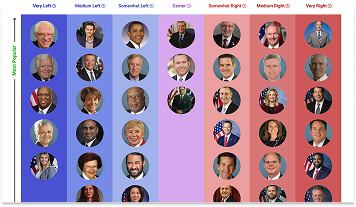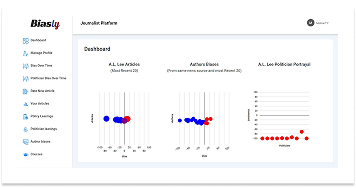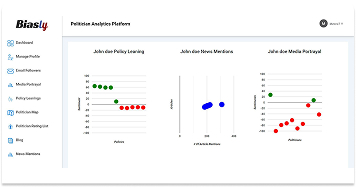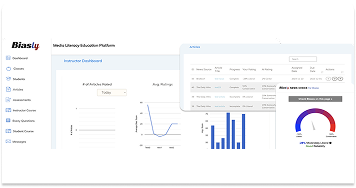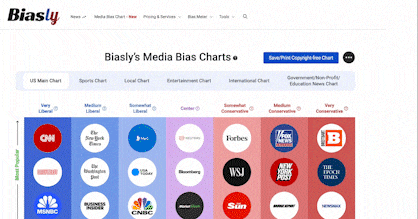Bias Meter
Extremely
Liberal
Very
Liberal
Somewhat Liberal
Center
Somewhat Conservative
Very
Conservative
Extremely
Conservative
-100%
Liberal
100%
Conservative
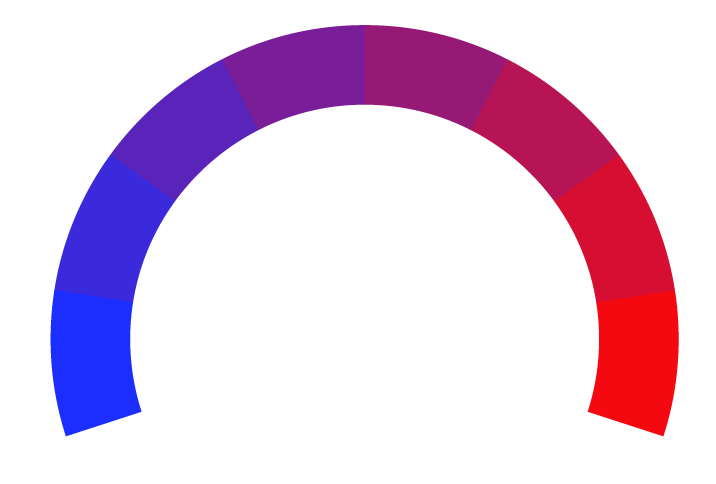
Biasly determines media bias ratings through a dual-layered approach combining artificial intelligence and analyst review. The platform’s proprietary bias detection engine, Bias Meter, evaluates sentiment, policy position alignment, and language framing across thousands of data points in news articles. Analysts then verify and interpret the AI’s findings, providing additional context where needed. Learn more
- Profile
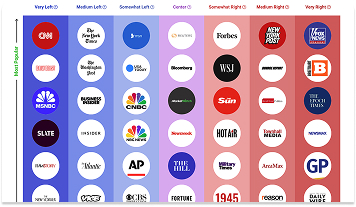
Mashable on the media bias chart
Mashable has a Bias Score of -32% Somewhat Left which is based on a variety of factors including its policy and politician leanings, article ratings, and the use of biased language. Its Reliability is rated as Good, and additional analytical insights are available in the other tabs.
- Bias Rating
-32% Somewhat Left
- ReliabilityPolicy Leanings
8% Center
Extremely
LiberalVery
LiberalModerately
LiberalSomewhat Liberal
Center
Somewhat Conservative
Moderately
ConservativeVery
ConservativeExtremely
Conservative-100%
Liberal100%
Conservative
Average Reliability
*Our bias meter rating uses data science including sentiment analysis, machine learning and our proprietary algorithm for determining biases in news articles. Bias scores are on a scale of -100% to 100% with higher negative scores being more liberal and higher positive scores being more conservative and 0% being neutral. The rating is an independent analysis and is not affiliated nor sponsored by the news source or any other organization.
Politician Portrayal90% negative
Continue For Free
Create your free account to see the in-depth bias analytics and more.
By creating an account, you agree to our Terms and Privacy Policy, and subscribe to email updates.
Policy Leanings Analysis
Policy | Bias score |
|---|
Mashable Editorial Patterns
Mashable’s coverage of political topics often reflects Somewhat Left bias, with consistent patterns in phrasing, source selection, and thematic focus that are Lean Left. While the publication demonstrates journalistic standards in many of its reports, the choice of issues, framing, and word usage can indicate a political slant. This content analysis examines how Mashable handles liberal and conservative issues and evaluates its language choices and editorial tendencies.
Coverage of Liberal vs. Conservative Topics
Mashable’s primary focus surrounds technology developments in electric vehicles, video games, social media, and artificial intelligence. Thus, they often do not discuss topics related to politics or similar. However, they do have a specific section on their website titled ‘Social Good’, which focuses on current social and political issues. These topics include the impacts of the Trump Administration’s tariffs, LGBTQ+ concerns, and Diversity, Equity, and Inclusion (DEI) programs. Despite this broad category, it sparsely covers right-leaning topics.
When discussing left-leaning topics, Mashable uses a positive tone, stressing the importance of these topics. They will often write harshly about the companies that are “anti-DEI” or any event or initiative that they consider to be anti-LGBTQ+.
Policy and Issue Framing
When discussing LGBTQ+ or DEI topics, Mashable often takes a supportive tone. They often emphasize support for members of the LGBTQ+ community and use strong language to describe those who oppose DEI or similar initiatives. One such example is an article titled “Meta’s latest dangerous decision: Siding with transphobes”, in which writer Leah Juliett states:
“That’s why the recent decision by Meta’s Oversight Board to not remove two anti-trans videos cuts deep. The videos show a transgender woman confronted for using a women’s bathroom and a transgender athlete winning a track race, and include the misgendering, demeaning, and endangering of trans people. By allowing two anti-trans videos to stay online, the Board hasn’t just failed its responsibility to users but sanctioned similar violence I once begged Meta to stop. And this time, the target is the trans community.
“This isn’t about algorithms or content policy. This is about life. And Meta just made a choice: platform hate over people. They chose wrong.
As mentioned previously, Mashable sparsely discusses right-leaning topics, but does frequently discuss the Trump Administration. When writing about the Trump Administration, Mashable takes a critical tone and uses negative words, such as the articles titled “Trump Administration detonates expansion of rural broadband access” or “Trump plans to kill Energy Star appliance program.”
Coverage and Relevance
Mashable does not frequently write about political bias, opting to stick to topics in the tech industry. While they do have a category dedicated to ‘Social Good’ and other societal issues, articles are infrequently posted.
When they do post to this category, however, it primarily covers left-leaning topics, as previously mentioned, such as DEI, LGBTQ+ equality, and social media concerns. Rarely do they cover conservative topics, such as gun control and freedom of speech concerns.
Readers who wish to further explore how Mashable compares with other publications can visit Biasly’s Media Bias Chart to analyze tone and word choice in real time.
Mashable Bias Analysis
Is Mashable Biased?
Based on Biasly’s evaluations, Mashable is rated as Somewhat Left.
Mashable was founded in 2005 by Pete Cashmore in Aberdeen, Scotland, United Kingdom. Initially, a technology blog solely authored by Cashmore, it would later gain popularity and land a place on Time’s 25 Best Blogs of 2009. Cashmore has not publicly stated his political beliefs.
By examining content patterns and the broader context of media influence, we aim to offer a balanced perspective on Mashable’s political bias.
How Does Biasly Rate News Sources?
Biasly uses proprietary algorithms and a team of analysts to provide comprehensive bias evaluations across thousands of news outlets. Over 200,000 articles from more than 3,200 sources have been analyzed to identify the most accurate and unbiased stories.
Biasly assigns each outlet three key scores:
- Reliability Score – Reflects factual accuracy
- AI Bias Score – Generated via natural language processing
- Analyst Bias Score – Assessed by human political analysts
These scores are based on seven core metrics: Tone, Tendency, Diction, Author Check, Selection/Omission, Expediency Bias, and Accuracy. These elements help analysts and algorithms evaluate the political attitude conveyed by each article.
Biasly’s Bias Meter ranges from -100% (most left) to +100% (most right), with 0% indicating neutrality. The system evaluates individual articles based on political terms, policies, figures, and sentiment to calculate precise bias ratings.
Is Mashable Politically Biased?
Mashable earns a Somewhat Left rating for its AI Bias Score, and Somewhat Left for it’s The Analyst Bias Score. The Analyst Bias Score, is generated by reviewers from liberal, moderate, and conservative backgrounds. Analysts reviewed 15 articles and noted preferences in areas like coverage of liberal politicians and policy topics such as abortion rights and clean energy. However, the paper maintained objectivity on topics like education and national security.
For example, coverage of racial minorities and affirmative action laws reflects a mostly neutral tone, but articles involving Black Lives Matter contributed significantly to the liberal score, with a -36% bias.
Although the demographics of Mashable readers are not publicly available, given the website’s focus on technology news, the majority of Mashable’s traffic likely comes from tech workers. Tech workers tend to lean left, according to an article in The Sociological Review.
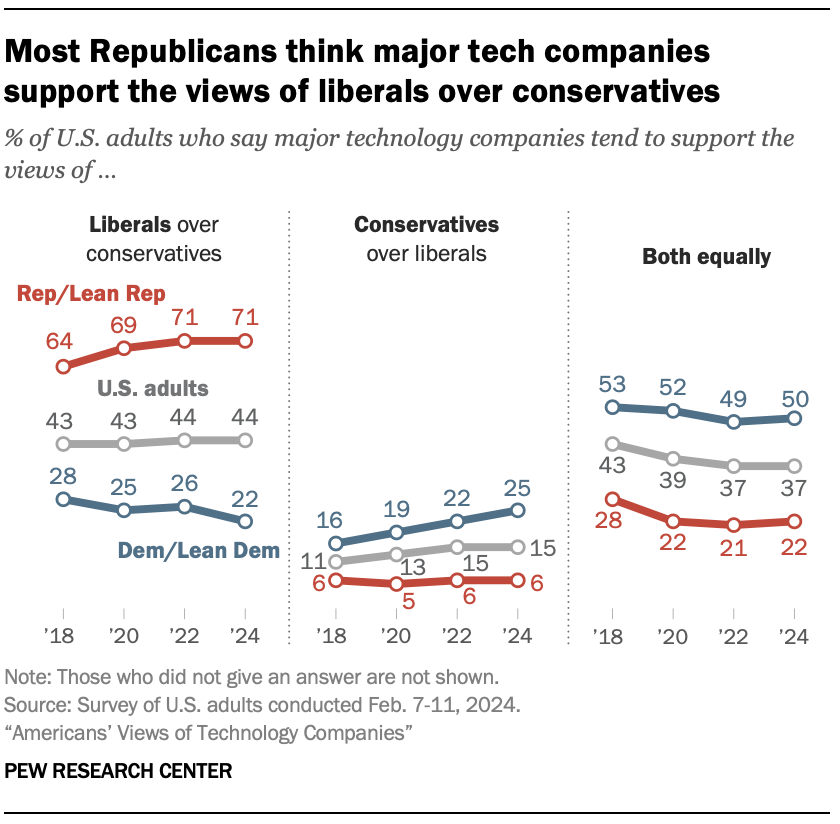
Source: Pew Research Center
It is also widely believed by right-leaning people that tech companies, and thus tech news organizations, favor left-leaning ideology over right-leaning ideology. Thus, it is likely that right-leaning people would be less willing to go to tech news sources for information. This may influence how they write articles. These demographics may signify a left-leaning bias, as news sources will typically post content that their audience will agree with.
This Bias score is determined through natural language processing that evaluates the tone, word choice, and opinion embedded in the reporting. Recent AI evaluations highlight liberal-leaning narratives in articles discussing the Trump Administration and LGBTQ+ issues.
Analysis of Bias in Mashable Online Articles
Whilst the primary topic of Mashable articles is related to technology and social media, they have opted to semi-frequently post articles dedicated to American politics and social topics. Thus, it is essential to ask—is Mashable biased?
To evaluate this, we can analyze select Mashable articles through several of Biasly’s bias rating criteria: Tone, Tendency, Author, Diction, and Expediency Bias.
- Tone: The overall emotion portrayed in word usage and focus.
- Diction: Words and general language chosen by the writer
- Author: The personal beliefs and work history of the writer
- Tendency: Patterns that the writer tends to follow
- Expediency Bias: Brief images or sentences are used to convey the message of the article

Source: Mashable
One such article, shown above, can show a left-leaning bias. Mashable uses words such as “demonstration” in the caption beneath the title, giving a less inflammatory tone. In the title itself, they do not give credit to who set the cars ablaze, implying a bias towards the protesters, thus a left-leaning bias.
Later in the article, the author speaks about the build-up to the event:
“By late Sunday, some of the protests turned violent as President Donald Trump authorized the deployment of National Guard troops and threatened to send military troops to the area. California Governor Gavin Newsom and Los Angeles Mayor Karen Bass both criticized Trump’s moves as ‘purposefully inflammatory’ and a ‘chaotic escalation.’
“Over the weekend, Trump attacked California politicians multiple times on his social media platform, Truth Social. On Sunday afternoon, he also called for bringing in military troops to respond to the protests. Trump also deployed National Guard troops to the protests.”
The author framed the passage so that the protests turning violent were a result of Donald Trump’s actions. They then give the response of two Democrat politicians, using the word “criticism,” implying a calm and rational response to Donald Trump. In contrast, the author uses the word “attacked” to describe Donald Trump’s response, implying the response to be aggressive and unprovoked.
The author of this piece, Rebecca Ruiz, does have a history of working for left-leaning news agencies. Ruiz contributed articles to news agencies MSNBC, NBC, and Al-Jazeera. She has also written for The Carter Center, a non-government organization founded by former democratic President Jimmy Carter, and the primary focus of her previous articles is mental health, a predominantly left-leaning topic.
Many Mashable articles follow a similar pattern to this article, often promoting the voices of left-leaning people or groups, promoting them as calm and thoughtful, while portraying right-leaning people or groups as aggressive and irrational. As seen in the article, the writer tends to talk more about left-leaning voices surrounding the event.
Analysis of Mashable Opinion Articles
Many publications also offer opinion articles, distinct pieces that offer the opinion or commentary of the author on a topic. These are often labeled clearly as opinion pieces at the top of the article. Mashable also offers opinion pieces, but does so less than many other publications.

Source: Mashable
In the above opinion piece, Mashable writer Leah Juliett speaks on the rollbacks of content protection policy and the filtering of potentially harmful videos and posts after the election of President Donald Trump. They take an unequivocal stance against these rollbacks, arguing consistently that Meta is platforming hate so that they may be viewed positively by Donald Trump. They use marked words, accusing that Meta has “sanctioned” violence, “cowardice”, and “gutted”.
This tone of unequivocal opposition towards Meta continues throughout the entire article, and can be summed up with their conspicuous closing:
“That’s why I’m writing this. Not just as a survivor, but as a witness. To say: this is not abstract. This is not academic. This is blood, bone, and breath. If Meta won’t protect us, we’ll protect each other. If they won’t listen, we’ll make them hear us. I made it out. But no one else should have to survive what I did just to grow up online.”
What is particularly noteworthy is that this dislike has not stayed within Mashable’s opinion articles. In a January 11th video on an article, Mashable writer Christianna Silva outright said that Mark Zuckerberg, the CEO of Meta, is “licking the boot,” a euphemism for submitting to the centralized authority. While the text in the article states that some critics are saying that, Silva outright said Zuckerberg was “licking the boot.”
One can distinguish Mashable’s opinion articles from their non-opinion articles by looking for the grey box with “Opinion” in the top left of the article, above the title. Despite this distinction, some of Mashable’s writers give their opinions in non-opinion articles.
Who Owns Mashable?

Source: Wikipedia
Mashable.com was founded in 2004 by Pete Cashmore in the United Kingdom, who had previously worked as a columnist on technology for CNN. Mashable was founded as a technology blog by Cashmore, who was the CEO of Mashable until 2017, when he sold the company to J2 Global, Inc., which later rebranded as Ziff Davis, Inc., a digital media company. Mashable later formed a union called the NewsGuild of New York with PCMag.com, another technology website owned by Ziff Davis, Inc.
It should also be noted that Mashable has received investments from investment firms prior to Ziff Davis’ purchase of the site in 2017. These firms consist of Turner, Time Warner Investments, New Markets Venture Partners, Tribune Media, and Updata Partners, according to tracxn.com. These firms generally make bipartisan donations.
Ziff Davis, Inc. owns multiple other publications, and it is noted that the majority of their international editions are published through smaller, independent editors. However, Mashable seems to be one of the only publications that provides semi-constant social commentary or political articles.
How to Evaluate Bias
Although Biasly rates Mashable as Somewhat Left, it’s important to remember that bias can vary from article to article. Mashable also covers a Lean Left state with objectivity on many issues, from state legislation to social developments. This complexity underscores the importance of examining each article individually. So, let’s learn how to evaluate media bias.
Recognizing media bias requires awareness and critical thinking. Often, readers trust news sources that affirm their existing beliefs—a psychological tendency known as confirmation bias. This makes it harder to identify slanted narratives or one-sided reporting.
To combat this, it’s essential to challenge your assumptions by consulting multiple viewpoints and verifying news through third-party analysis. Tools like Biasly’s media bias ratings allow readers to compare the same news story across the political spectrum.
Ultimately, bias isn’t always a matter of what is said—it’s also about what is left out, how topics are framed, and which stories are chosen for coverage. Learning to recognize these patterns can help readers make more informed decisions and develop greater media literacy.
To start comparing news outlets and gain a better understanding of bias, sign up for Biasly’s Media Bias & News Analytics Platform to see how stories vary between sources.
Mashable Reliability Analysis
Is Mashable Reliable?
Mashable finds itself toward the middle of the spectrum, with neither high nor low accuracy. Its status as a local news outlet contributes to its moderate reputation for reliability. According to Pew Research, Americans generally hold less politically polarized views toward local news compared to national media. In fact, 85% of adults regard local journalism as at least somewhat important to their community. However, another Pew study reports that satisfaction with local political news coverage remains disproportionately low relative to its airtime.
This suggests that Mashable’s popularity among Utah residents may not stem from the reliability of its political news coverage. Further investigation is needed to determine whether bias or other factors are affecting its accuracy. At Biasly, we specialize in evaluating not just bias but also the reliability of media outlets. Let’s explore the accuracy and trustworthiness of Mashable.
How to Evaluate Reliability?
Reliability refers to how trustworthy or accurate a news source is. If we can’t trust what we read, then continuing to consume content from that outlet serves little purpose. So, how do we evaluate a news outlet’s reliability?
There are several potential measures of reliability to look out for when trying to determine whether a media source is reliable or not. Red flags for an unreliable article can include the presence of wild, unsubstantiated claims, facts dependent on other unreliable sources, heavy use of opinionated language, and more. In contrast, hallmarks of a reliable source include:
- Absence of subjective language
- Citing credible sources (e.g., .gov, .edu, academic references)
- Verifiable facts and statistics from multiple outlets
- Use of primary sources, like interviews or transcripts
- Consistency with coverage across other platforms
Biasly’s reliability scores incorporate these elements in evaluating media outlets.
So, How Does Mashable Fare in Its Reliability?
The political reliability index developed by Biasly assesses both accuracy and trustworthiness. Mashable currently holds Good Reliability Score, which is calculated as a weighted average of:
- Fact Analysis Score – Evaluates the accuracy of claims, facts, and evidence.
- Source Analysis Score – Assesses the number, diversity, and credibility of sources and quotes used.
Mashable’s Source Analysis Score is rated Good at 77%. This suggests moderate trustworthiness in its sourcing practices. The score is AI-generated and considers quote length, frequency, diversity, and quality.
The Fact Analysis Score has yet to be finalized. This score will further determine how well Mashable supports its claims, addresses selection and omission bias, and presents verifiable evidence. Until this is available, readers are encouraged to perform their own evaluations using Biasly’s media bias tools.
While the majority of Mashable articles rely on fact-based reporting, there are occasional lapses in which the bias of the author takes over. In certain pieces, the author leaves out crucial details or voices on the matter.
Mashable’s Accuracy and Reliability
According to Biasly’s analysis, Mashable maintains Good Reliability Score, but individual articles may vary significantly. Let’s dive into the details.
To holistically analyze the reliability of Mashable, you must analyze its political orientation and biases. Mashable, which tends to have a left-leaning political bias, may also tend to omit information or right-leaning voices on the matter. Refusing to address opposing views can be dangerous, as you are unlikely to see the full picture while only listening to a single side of the topic.
Two common types of bias that affect factuality include:
- Selection Bias – Highlighting or omitting stories to fit a particular narrative.
- Omission Bias – Leaving out differing perspectives or relevant details to skew perception.
Biasly’s accuracy ratings use a scale from 1% (least accurate) to 100% (most accurate). Factors include the presence of supporting evidence, internal and external reliable sources, and balanced viewpoints.
For instance, Biasly gave the BizPac Review a Somewhat Conservative Bias and an Average analyst reliability score. One such BizPac article is titled “Chris Cillizza says corporate media was ‘too willing’ to buy Biden team’s line that he was fit as a fiddle.” This article showed a 40% reliability rating for failing to include diverse viewpoints and employing inflammatory language. Further, Cohen did not include opposing viewpoints, sticking only to conservative views.
In contrast, another piece from the outlet, titled “SCOTUS will hear case that could result in country’s first taxpayer-funded religious charter school” featuring legal and political sources with balanced quotes, was rated as Center and scored high for accuracy. The most significant language opposing liberal views here belongs to a politician, whose position naturally required involvement with local education systems. Vivex Saxena reported:
“The plan is supported by Oklahoma State Superintendent Ryan Walters: The problem is that charter schools are considered public schools by default.”
This quotation is characteristic of Saxena’s writing throughout the article, as her unique variation of sources and more extensive quotes produced Good and Excellent reliability ratings on Biasly.
We will take a closer look at more examples like this below to provide a further investigation into the reliability of Mashable’s articles. This will include its use of selection bias, omission bias, and the quality of its sources and the facts it uses.
Analysis of Reliability in Mashable’s Online News Articles
Generally, Mashable is upfront with its sources and facts, despite there being a left-leaning trend. When a Republican does something that Mashable approves of, they will attempt to recognize it. However, these rare scenarios often shift the credit for the event to a broader group.
Take, for example, an article titled ‘It’s now a federal crime to publish AI deepfake porn’. While Mashable does mention that it was Trump who signed the law in the caption and the body of the article, they notably do not recognize Trump’s role in the title, opting to simply state that ‘it’s now a federal crime’.
Quality of Sources and Facts Used
Among the largest issues on reliability for Mashable is the sources they use for their articles, as they often come from Democratic politicians or left-leaning news organizations. Thus, they are likely to come into biased information that may not be entirely reliable.
The article titled ‘Trump’s anti-DEI focus appears to stall multilingual emergency alerts’ is no different. While much of the article is indeed factual, writer Chase DeBenedetto seems to only draw sources from left-leaning voices.
DeBenedetto only includes one side of the debate, failing to give the opinions of the Trump Administration on this point. Most notably, Democratic US Representative saw her opinion shown in the article.
“You’ve got about 68 million Americans that use a language other than English and everybody should have the ability to understand these emergency alerts. We shouldn’t be looking at any politicization of alerts — certainly not because someone’s an immigrant or they don’t know English,”
But the article does not show the official message from the Trump Administration on this. This may be harmful, as readers only gain half of the story about the event, thus not having all the factual information. The quote is also the only full quote in the article, making the reader have to deliberately look through the rest of the sources to decipher the direct words.
When analyzing the sources used in this article, you see a similar trend.
Sources cited include:
- Los Angeles Times
- Nanette Diaz Barragán, California U.S. Representative
- Federal Communications Commission
- NPR
- PBS
Among this list, you can find three news agencies, one U.S. Representative, and a federal agency. While the federal agency can be considered a trustworthy source of unbiased information, the others might not be. The three news agencies—the Los Angeles Times, NPR, and PBS—have all been typically considered left-leaning. It appears that four out of the five sources in the article are left-leaning and none are right-leaning.
This propagates a problem; Mashable does not typically take sources from across the political spectrum. Thus, they are more likely to ignore right-leaning points of view. Refusing to acknowledge their views inherently negates them, only allowing the reader to hear the left-leaning voices, thus making them susceptible to bias.
Selection and Omission Bias
Mashable tends to cover technology topics, even in the ‘Social Good’ category, due to the website being technology-oriented. Mashable tends to speak on subjects in politics that address technology concerns, particularly electric vehicles, artificial intelligence, and Social Media.
The most common way they show their bias is through selection bias, as seen in ‘After mass layoffs, IRS to plug holes with AI’. This article details the plan the Internal Revenue Service (IRS) has laid out to address ‘workforce holes’.
While much of this article is certainly factual, Mashable seems to have selected this story as the root cause of the ‘workforce holes, ’ the large number of layoffs following Trump’s inauguration as president. A large section of the article was dedicated to explaining the layoffs and downsizing attempts by the administration, and only focuses on the layoffs themselves, without discussing the goal of the layoffs or the reasons that the Administration has for these layoffs.
While explaining the layoff is certainly beneficial, the primary problem lies in not explaining the reasons or justifications for it. Mashable omits these justifications and only provides the right-leaning view on what the plan is going forward, not on what has already happened.
Mashable also chose specific sources, which tend to be left-leaning news sources, such as CBS. However, the majority of their sources come from other Mashable articles or federal websites. This article does better than most when providing opposing views, as it provides a quote from the Trump Administration on the matter.
“I believe, through smarter IT, through this AI boom, that we can use that to enhance collections. And I would expect that collections would continue to be very robust, as they were this year,”
There were no quotes from left-leaning sources, which can be an attempt to balance the scales of bias.
So, Is Mashable Reliable?
Overall, Mashable can be considered to be very reliable news outlet. It demonstrates a consistent goal of journalistic integrity and typically supports claims with sources and quotes. Occasional omissions and framing bias do appear, particularly on culturally sensitive or partisan issues.
As media literacy improves, readers can more easily detect issues with selection bias, omission bias, and factuality. To strengthen your ability to assess reliability across the political spectrum, use Biasly’s Side-by-Side News Checker to compare how multiple outlets report the same story.
This empowers you to consume more accurate, balanced, and dependable news.
Additional Insights
News Source Comparison
Mashable is not often compared to other websites or news sources. The only common comparison is TechCrunch.com, another technology-focused website. The notes people make between the two are that Mashable tends to focus on the social media, gaming, and societal side of technology, while TechCrunch focuses on the business side of technology. Mashable is the only one of the two that makes political articles.
Related Tools and Resource Pages
To better understand how Mashable fits into the broader media landscape, we recommend exploring these helpful resources:
- Media Bias Chart: See where Mashable ranks among hundreds of media outlets across the political spectrum.
- Political Bias Chart: Visualize political slants of news sources across various policy areas.
- Journalist Bias Analytics Platform: Explore how individual journalists contribute to bias within their publications.
- Politician Bias Analytics Platform: Compare how politicians are framed differently by Mashable and other outlets.
- Media Literacy Education Platform: Learn how to critically assess media sources, bias techniques, and news reliability.
Frequently Asked Questions
Mashable is rated as Somewhat Left based on Biasly’s media bias algorithm, which assesses sentiment, article framing, and policy favorability.
There have not been any significant accusations of misinformation; however, Mashable does have the tendency to omit information from right-leaning views. Generally, the information they provide is factually correct but incomplete.
Biasly uses a combination of AI sentiment analysis and human analyst review to assess tone, fact accuracy, source quality, and media bias indicators. Learn more on our Bias Meter page.
Dependent on the subject. If you wish to learn about technology, electric vehicles, video games, and social media, then Mashable provides clear, fact-based reporting. However, Mashable is very left-leaning in the ‘Social Good’ section and articles related to the Trump Administration, DEI, or LGBTQ+, thus, in our opinion, they have limited reliability in covering political news.
Ratings are based on recent news using data science and A.I. technology.
Military Spending
| Date | Sentiment | Associated Article | Snippet |
|---|---|---|---|
| 08/25/2019 | 75% For | Trump Family Detentions Flores Agreement (link) | So, of course, the Trump administration is doing the opposite in a baldfaced |


























